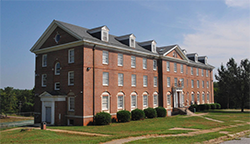Historically black colleges and universities may have to move to business model
LAWRENCE — Funding cuts to higher education have presented challenges to institutions across the country but have hit historically black colleges and universities especially hard. Combined with numerous other challenges the schools, commonly known as HBCUs, face, they have forced some schools to close their doors and may do the same to others. A University of Kansas professor who studies HBCUs says moving to a business model may be key to survival, but it could ultimately change the schools’ mission, and a focus on accreditation is vital.
 Jerry Crawford II, associate professor of journalism, has published an article in the Journal of Research Initiatives examining accreditation, governance and survival challenges that come with the “ever-increasing competition for funding and students” at HBCUs. Established in the aftermath of the Civil War, HBCUs were institutions that provided education to newly freed slaves and free blacks who could not enroll in state schools.
Jerry Crawford II, associate professor of journalism, has published an article in the Journal of Research Initiatives examining accreditation, governance and survival challenges that come with the “ever-increasing competition for funding and students” at HBCUs. Established in the aftermath of the Civil War, HBCUs were institutions that provided education to newly freed slaves and free blacks who could not enroll in state schools.
Much has changed in the century-plus since then, and several HBCUs have had to close their doors due to a lack of students and funding. Students who traditionally attended the schools are now being actively courted by larger schools, and legislatures in states that are home to them have worked to eliminate duplication in programs and academic offerings, a practice that almost never happens in other states, Crawford said. Research has shown that 60 to 80 percent of students enrolled at HBCUs depend on Pell Grants to pay for their schooling.
“I wanted to look at what the challenges are of getting students at HBCUs,” Crawford said. “A smaller school now has to compete with the state school, and when the students leave, what follows them? Federal dollars. When you start losing federal money, these schools can’t afford that.”
 St. Paul’s College in Lawrenceville, Virginia, is a pertinent example, Crawford said. The school had educated students for 124 years but lost its accreditation in 2012 when it was found to be deficient in several financial areas. The school eventually closed its doors. That can have numerous and wide-ranging ramifications: Students attending the school lose credit hours they have earned but keep accumulated debt. And the institutions are economic engines in their communities and regions, providing jobs, support for the local tax base and support to area businesses, Crawford said.
St. Paul’s College in Lawrenceville, Virginia, is a pertinent example, Crawford said. The school had educated students for 124 years but lost its accreditation in 2012 when it was found to be deficient in several financial areas. The school eventually closed its doors. That can have numerous and wide-ranging ramifications: Students attending the school lose credit hours they have earned but keep accumulated debt. And the institutions are economic engines in their communities and regions, providing jobs, support for the local tax base and support to area businesses, Crawford said.
The school was given two years' notice that it needed to raise $5 million. Being unable to do so highlights the importance of governance at the schools. In turn, many HBCUs and small schools are turning to leaders from the business world or with finance backgrounds to focus on keeping the schools solvent, Crawford said. The problem that creates is shifting away from the original mission of educating students who could not be educated elsewhere. People often ask if HBCUs are still necessary, and Crawford argues they are still vital.
“To me, that’s counterproductive,” Crawford said of a switch to a business model from an education focus. “But I see no other way than that some of these schools will be shuttered if they don’t. We can say ‘We don’t need these schools, because if you’re black, you can go to any school.’ But for many students, how can they?”
Crawford points out that many HBCU attendees, who are in fact a diverse group and not just African-Americans, go on to work in their home communities and cities in which the institutions are located. Teachers especially tend to work in their hometowns or adopted communities after graduation. Journalists also tend to work in their communities after graduating from HBCUs, and research has shown that as many as 80 percent of African-American media professionals have some connection to HBCUs.
“You can’t replace that or put a dollar figure on it,” Crawford said. “If you lose that, you’re losing generations.”
Journalism and education may provide examples of how to meet the challenges HBCUs face. The two disciplines have proven to be adept at maintaining accreditation in their fields at HBCUs, a factor vital to the schools’ survival. Governance could do well to study how the disciplines maintain their accreditation — which do not come without significant challenges of their own — and attempt to apply those lessons to the larger institution. Funding, naturally, is key, but not the only solution, Crawford said.
In future research, Crawford hopes to assist HBCUs in achieving that goal. His plan is to do six-month, in-depth studies with a random sampling of the nation’s 103 HBCUs. By conducting the study with the schools’ leaders, professors, students and outside leaders such as legislators, community leaders and local governments, he hopes to produce a roadmap, or collection of best practices, for HBCUs to consider. Above all, the goal is to help gather the collective knowledge and success stories of HBCUs, coupled with insight from policymakers and higher education leaders, to help the historical institutions keep their doors open and continue to fulfill their mission of providing quality education for students and support for their communities.